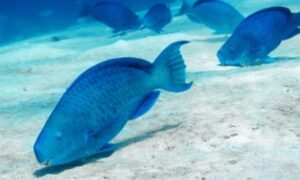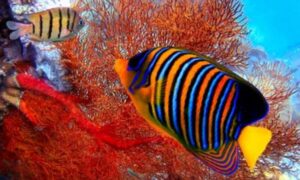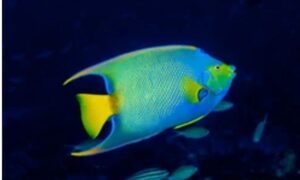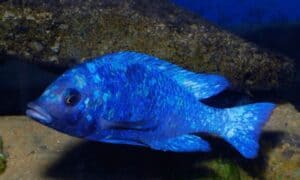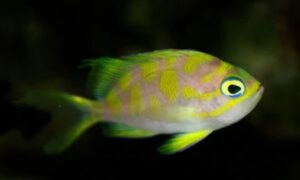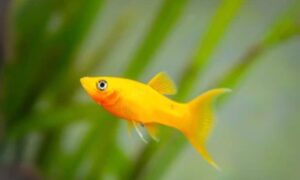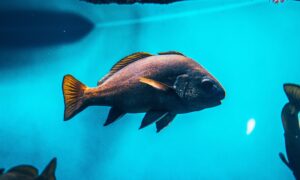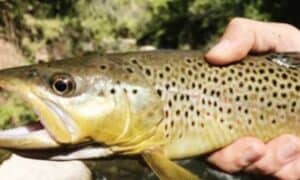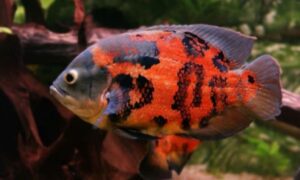Table of Contents
Introduction to Jaguar Cichlid
Jaguar cichlid is one of the most popular cichlids from the family of Cichlidae. Their scientific name is Parachromis managuensis. They are a popular choice among fish keepers because of their bold, fierce look and personality. They are also called Managuense Cichlids or Aztec Cichlids.
It can be a little trick to keep jaguar cichlids as your pet so I only recommend you to keep them as your pet if you already have some experience in keeping cichlids. This is because jaguar cichlids are super aggressive so you need to have some basic cichlid-keeping experience before you chose to keep jaguar cichlid as your pet.
But what makes them special is that they are fierce, hardy, active swimmers and long-life fishes. Yes, you heard it right!! They have a long lifespan.
Natural habitat of Jaguar Cichlid
Jaguar cichlid is native to Central America. They were discovered in Lake Managua which is in Nicaragua. Since now countries do export fish so jaguar cichlids can be found in freshwater bodies in Honduras, Costa Rica, Mexico, Panama, etc
In the wild, jaguar cichlids are living in warm waters which have a neutral pH. The best thing is jaguar cichlid is a hardy fish and can adjust to many environments.

Appearance
The Jaguar cichlid is a very fascinating and appealing fish. Jaguar cichlid has a long oval-shaped body. Their fins are supported by spiny rays. Jaguar cichlids have quite obvious dorsal and tail fins.
Their coloration and pattern are also very beautiful and interestingly they change their appearance as they grow up. When they are young, their bodies have a pale golden-silver hue color and they also have black bands wrapped around the back of fish which finishes around the lateral line. As jaguar cichlids become adults the black bands will slowly turn into dots. This will give them a very beautiful jaguar pattern and from this feature, they got their name “Jaguar cichlids”
Another interesting feature is their jaw!! Their lower jaw extends slightly beyond the upper jaw. They also have sharp teeth which helps them in hunting.
When jaguar cichlids are in captivity, they can grow up to 14-16 inches in length. Also, female jaguar cichlids are slightly smaller than male jaguar cichlids.
The size of the jaguar cichlid can get affected depending on its environment. For example, if they are living in a big tank and their nutritional requirements are fulfilled then they will grow to their full size and if the situation is the opposite then they won’t grow much.
What is the difference between male and female jaguar cichlid
Male and female jaguar cichlids have quite obvious differences. Male jaguar cichlids have long and extended dorsal and anal fins. Male jaguar cichlids are also large in size than female jaguar cichlids.
Care requirements of Jaguar Cichlid
Jaguar cichlids are large and aggressive and this is why I only recommend keeping them as your pet if you are an experienced fish keeper and if you know more about cichlids. But that doesn’t mean it’s hard to take care of them!!
No!! It isn’t that hard since jaguar cichlids are hardy species so they adapt to several environments really well. The main factors you need to consider are that the water quality should be really good, the tank should be big and clean, the temperature should be accurate, etc
Let’s move further and check out their requirements in detail

Tank size and tank setup
The tank size of jaguar cichlids depends on their age and size. This is because this fish can even get 16 inches in size if they are in good condition, so this means you need a larger tank for them.
If you have a young jaguar cichlid as your pet then a 30-gallon tank is enough for them. But they grow fast so for one adult jaguar cichlid you need at least 70 gallons tank. If you are keeping a breeding pair then you must have 180 gallon tank so they can have enough space for swimming. If you keep them in a small tank it can make them more aggressive.
For tank setup you should have a sandy substrate since they like to dig so sandy substrate is safe for them.
For decorations in the tank, add synthetic plants because jaguars cichlids can eat live plants. Also, add driftwood and rocks to the tank. This will give the jaguar cichlid some places to hide.
The filtration system is also very important in the tank because the jaguar cichlid produces lots of waste on an everyday basis so a strong filter is very important.
Ideal water parameters
It’s very important to maintain accurate water parameters in the tank.
Water parameters are mentioned below
| pH levels | 7.0–8.7 |
| Water temperature | 73°–82° Fahrenheit |
| Water hardness | 10–15 |
| Minimum tank size | 70 gallons |
Points to be noted
- Make sure the tank is clean every time
- The tank should be large
- Add fake plants and sandy substrate
- Add driftwood and rocks for hiding spots
- Make sure the water parameters are accurate
Diet of Jaguar Cichlids
What does a jaguar cichlid eat?
Jaguar cichlid is carnivorous!! Jaguar cichlids are really aggressive and they will literally eat any tiny creature which is in their tank.
Since they are carnivorous so you should feed them with a protein-rich and meaty diet. You can add bloodworms, brine shrimps, etc to their diet.
You can also feed them with pellets and flakes. You should feed them regularly, two times a day.
Points to be noted
- Make sure their nutritional requirements are fulfilled
- Make sure jaguar cichlids don’t stay hungry for longer periods
- Don’t overfeed jaguar cichlids as overfeeding can cause bloating and digestion issues
- Feed them protein rich meaty food
Breeding of Jaguar Cichlids
If you are thinking to breed jaguar cichlids then don’t worry!! It’s quite easy to breed jaguar cichlids.
Follow these steps for breeding
- If you have some male and female jaguar cichlids together in a tank, they will form a pair naturally
- For the breeding process, raise the temperature of the tank by 2 or 3 degrees.
- Feed your jaguar cichlid protein-rich and meaty food items
- Jaguar cichlids may become more aggressive during breeding time so shift your jaguar cichlids in a separate breeding tank to keep your other fishes safe and secure.
- The belly of female jaguar cichlids will become bloated when it gets filled with eggs
- Female jaguar cichlid will lay their eggs in a rock or cave.
- It can lay 2000 eggs at one time
- When a female lay her eggs the male jaguar cichlid will fertilize it.
- Jaguar cichlids are very protective and they will protect their baby fry.
- The eggs will hatch in 5-6 days
- After a week the fry will be able to swim around in the tank
- When the baby fry is able to swim then remove the adult jaguar cichlid from the tank
- You should feed small brine shrimps and tiny pieces of bloodworms to the baby fry
This is the complete process of breeding.
Is jaguar cichlid aggressive?
Jaguar cichlids are extremely aggressive!! It will bully, eat, and bite tiny fishes that come in their way so as a fish owner you shouldn’t add tiny fishes with jaguar cichlids as they might eat them. You should add the same size of fish as jaguar cichlids so they don’t attack them.
They are also territorial and they need their own space where they can rule. So make sure the tank is large enough so jaguar cichlid can have their own territory.
Jaguar cichlids is an active fish so you must have a large tank so it can swim freely around. Jaguar cichlids are active in the morning so they will swim all day and sleep all night.
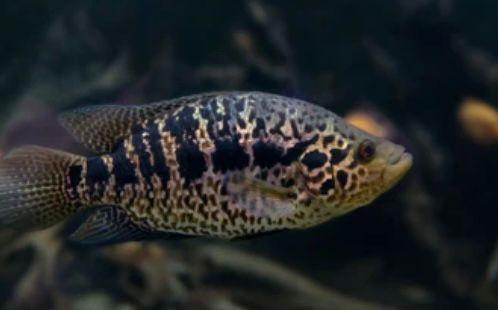
Ideal tank mates
Jaguar cichlid is highly aggressive and territorial so you must be careful while choosing tank mates for them. You shouldn’t add any tiny fish with them as the jaguar cichlid will attack them.
The ideal tank mates for jaguar cichlids are other types of jaguar cichlids. If you are adding more than one jaguar cichlid in the tank, then add all of them at the same time in the tank so they can grow up together and become friends.
You can also add other fishes of the same size as jaguar cichlids. Some other best tank mates for jaguar cichlids are
- Red devil cichlid
- Convict cichlid
- Green terror cichlid
- Oscar fish
- Sailfin Pleco
- Green terror cichlid
- Texas cichlid
- Wold cichlid
- Bala shark
- Jack dempsey
- Flower horn cichlid
- Blue acara cichlid
These are some other suitable tank mates for jaguar cichlid.
Disease and parasites
Jaguar cichlids can get affected by diseases that normally occur in freshwater species like ich. It is a very common disease. The symptoms of this disease are white spots on the body of the fish. Also, it’s a contagious disease so you should separate the affected fish for keeping your other fish safe.
You can treat this disease with some drops which are available in pet stores. Once you observe that the white spots vanished, then you can shift the affected fish to the original tank.
Reasons your jaguar cichlid might get sick
- The tank is not clean
- Water parameters are not accurate
- Temperature of the tank is not accurate
- You might not be fulfilling the nutritional requirements of jaguar cichlid
Conclusion
Is a jaguar cichlid a good pet? Yes!! It can be a good pet if you have an experience with cichlids. You need to know the basics about cichlids and their nature before keeping the jaguar cichlid as your pet.
They can be a great addition to your tank. They are beautiful and active at the same time. They will definitely keep you entertained by swimming all day long. They are aggressive and territorial but you can definitely reduce their aggression if you take care of their requirements. Jaguar cichlids are from the Cichlidae family and they are popular pets all over the world.


